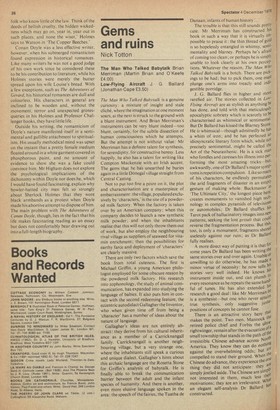Gems and ruins
Nick Totton
The Man Who Talked Babytalk Brian Merriman (Martin Brian and O'Keefe ┬Ż4.00) Low-Flying Aircraft J. G. Ballard (Jonathan Cape 0.50) The Man Who Talked Bahytalk is a genuine curiosity : a mixture of insight and stale clich├®, where the imagination at one moment soars, at the next is struck to the ground with a blunt instrument. And Brian Merriman's instruments can be very blunt indeedŌĆötoo blunt, certainly, for the subtle dissection of human consciousness which he attempts. But the attempt is not without value: Mr Merriman has a definite talent for synthesis, for serendipity, for constructive heresy. Less happily, he also has a talent for writing like Compton Mackenzie with an Irish accent. The gems that he has unearthed he buries again in a little Donegal village straight from Central Casting.
Not to put too tine a point on it, the plot and characterisation are a masterpiece of embarrassment : the village, populated exclu sively by 'characters,' is the site of a powdered milk factory. When the factory is taken over by an American company; when this company decides to launch a new synthetic milk powder; and when the inhabitants realise that this will not only throw them out of work, but also empiloy the neighbouring rival village as suppliers of seaweed for vita min enrichment ; then the possibilities for earthy farce and deployment of 'characters' are clearly massive.
There are only two factors which save the book from total cuteness. The first is Michael Griffin, a young American philo logist employed for some obscure reason by the powdered milk factory. His research into zophonology, the study of animal com munication, has expanded into studying the language of babies. It also puts him in con tact with the second redeeming feature, the eccentric autodidact Gallagher the Inventor, who when given time off from being a 'character' has a number of ideas about the nature of language.
Gallagher's ideas are not entirely abstract: they derive from his cultural inheritance as a member of a Carricknangall family. Carricknangall is another neighbouring village, but a very strange one, where the inhabitants still speak a curious and unique dialect. Gallagher's hints about this archaic language are the Rosetta Stone for Griffin's analysis of babytalk. He is finally able to break the communication barrier between the adult and the infant species of humanity. And there is another, even more elusive language spoken in the area: the speech of the fairies, the Tuat ha de Danaan, infants of human history ...
The trouble is that this still sounds prettY cute. Mr Merriman has constructed his book in such a way that it is virtually itr" possible to praise it : the thin thread of gold is so hopelessly entangled in whimsy, send' mentality and blarney. Perhaps he's afraid of coming too clean; or perhaps he is simPlY unable to look clearly at his own perce19' tions. Whatever the reason, The Man Who Talked Bahytalk is a botch. There are pickings to be had; but to pick them, one must plunge one's arms into treacly and inch' gest ible porridge.
J. G. Ballard flies in higher and more rarefied air. The stories collected in Low
Flying Aircraft are as stylish as anything he has done, and told with that meticulously' apocalyptic sobriety which is scarcely to he characterised as whimsical or sentimental. But Dr Ballard has kissed the Blarney Stone. He is whimsicalŌĆöthough admittedly he has a whim of iron; and he has perfected an idiosyncratic literary form which, while not precisely sentimental, might be called the Art of the Neurasthenic. He is a sick man who fondles and caresses his illness into Per' forming the most amazing tricksŌĆöbut, awkwardly, one cif DrItallard's major syrriP" toms is repetition compulsion. Likes┬░ manY of his characters, he endlessly permutates the arid fragments of disaster in an emPtY gesture of making whole. Buckmaster in 'The Ultimate City,' the longest piece here, creates monuments to vanished high tech' nology in complex pyramids of televisions or automobiles; Dr Ballard shuffles his Tarot pack of hallucinatory images into nev",. patterns, seeking the lost gestalt that couln reverse the fragmentation process. But this, too, is only a monument, fragments shored uselessly against our ruin; as Dr Ballard fully realises. A more direct way of putting it is that for some years Dr Ballard has been writing the same stories over and over again. Unable or unwilling to do otherwise, he has made a minor virtue of necessity: he now tells his stories very well indeed. He knows his instrument inside out, and can plumb i,ts every resonance as he repeats the same hann' ful of tunes. He has also extended his research a good deal: like Mr Merriman he is a synthesistŌĆöbut one who never attains true synthesis, only suggestive ji.octa" positions of concepts he cannot fuse. There is an attractive story here that makes the point. Two men, Mannock II retired police chief and Forbis the ulti"; rightwinger, remain after the evacuation ni small township that stands in the path of irresistible Chinese advance across 1, America. They know they can do nothln.: against the overwhelming odds; but ar compelled to stand their ground. When 01" Chinese do advance, they experience the on: thing they did not anticipate: they ae simply jostled aside. The Chinese are siniPI,Y, not interested in them, much less thel motivations; they are an irrelevance. Whas an elegant self-analysis Dr Ballard ha constructed.






































 Previous page
Previous page